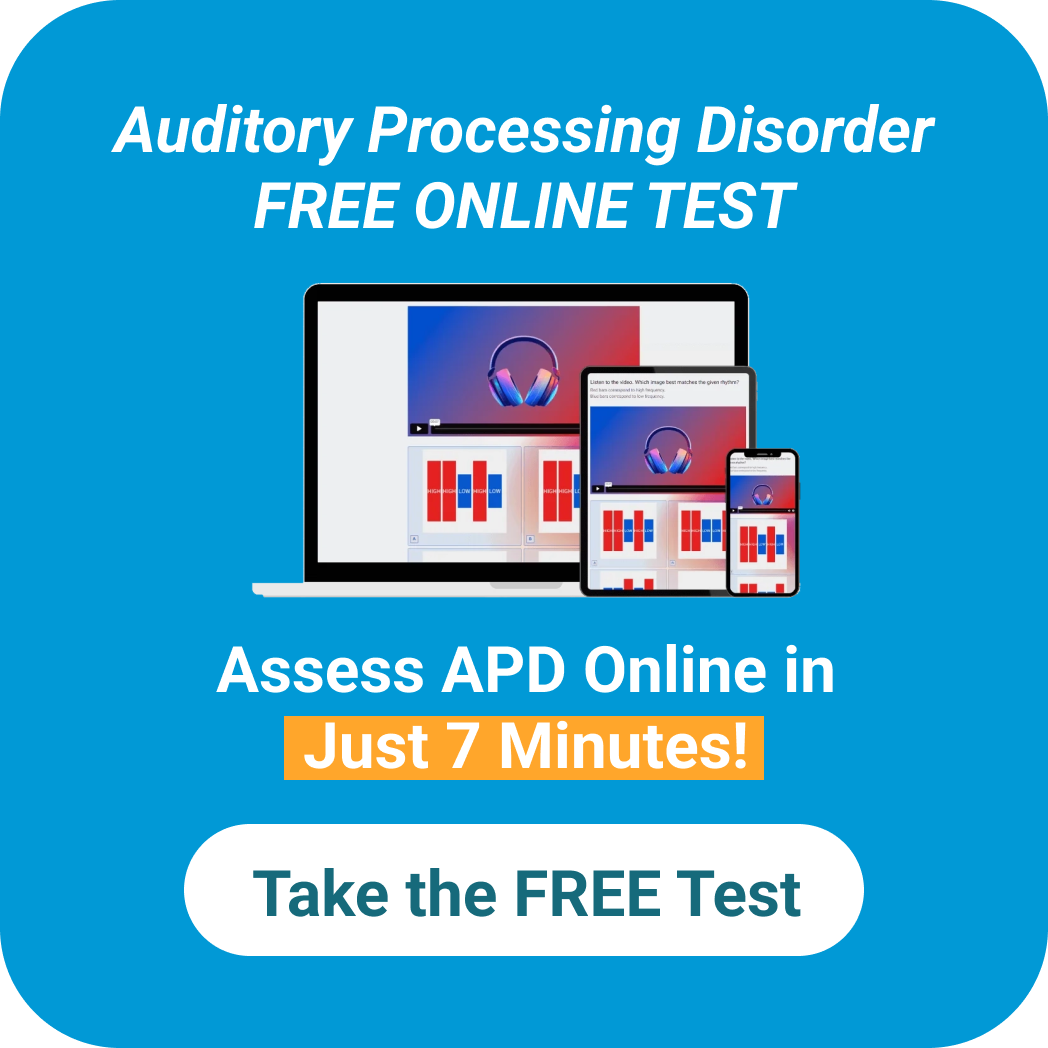Auditory Processing Disorder and ADHD: Differences, Strategies, Assessment
 Amanda Unrau
Amanda Unrau CCC-SLP
September 11, 2023

Auditory Processing and ADHD: Similarities | Auditory Processing and ADHD: Differences | Can ADHD be Misdiagnosed as APD? | Auditory Processing and ADHD Assessment | Strategies for Coping with ADHD and APD | Using Forbrain
ADHD (Attention Deficit Hyperactivity Disorder) can be connected to APD (Auditory Processing Disorder) because ADHD impacts one’s ability to understand incoming auditory information. However, although they are related, it is important to understand how APD is similar to and different from ADHD. In this article, we will explain the similarities and differences between ADHD and Auditory Processing Disorder, what an assessment of each entails, and strategies for coping with both APD and ADHD.
Auditory Processing and ADHD: Similarities
Auditory Processing Disorder and ADHD have many similarities. Both disorders have similar symptoms. In fact, many symptoms of APD can mimic those of ADHD. Let’s go over the symptoms of both.
APD Symptoms
- Difficulty focusing and paying attention
- Difficulty following multi-step directions
- Difficulty locating the source of the sound, especially in noisy environments
- Difficulty understanding quick speech
- Misunderstanding messages such as not picking up on changes in prosody indicating sarcasm
- Longer response time
- Often asking for repetition
- Poor musical skills and difficulty learning songs and nursery rhymes
- Problems with reading, spelling, and learning
- Acting unsettled in noisy environments
ADHD Symptoms
- Difficulty concentrating and staying focused
- Appears not to listen
- Difficulty preparing for and completing tasks in a timely manner
- Restless and unable to sit still
- Bounces from one thing to the next without completing the first task
- Tries to multitask but is unsuccessful
- Impulsive
- Disorganized
- Difficulty learning new things
As you can see from the lists above, APD and ADHD have similar symptoms. An individual with either APD or ADHD may have difficulty focusing and paying attention, require additional time to complete tasks, and have difficulty learning. It is possible for an individual to have both APD, ADHD, or both.
Auditory Processing and ADHD: Differences
Although auditory processing and ADHD have a lot in common, they do have differences. Below are a couple ways you can distinguish Auditory Processing Disorder vs ADHD:
ADHD is a neurodevelopmental and behavioral disorder, not a central nervous system disorder. The areas of the brain that process auditory information are not involved. Those with ADHD have deficits in executive functioning, which is located in the prefrontal lobe of the brain. This leads to hyperactivity, procrastination, and difficulty planning and executing tasks.
APD is the result of deficits in the neural processing of auditory information in the Central Auditory Nervous System. This means that those with APD will have more difficulty completing or participating in tasks involving sound. Individuals with APD are often able to complete a reading task more easily than a listening task. They are not able to recognize and identify key differences in the sounds of words, making it hard for them to accurately interpret and decipher speech. A child with APD can confuse “hot” with “pot” or “flip” with “slip”. This child will especially struggle in loud environments with a lot of background noise.
In daily life, someone with ADHD will appear to jump from task to task and have an inability to maintain focus enough in order to complete one task at a time. On the other hand, an individual with APD’s ability to complete tasks will vary. They may be able to complete written tasks, but seem unable to follow instructions and look around at others to find out what to do.
Can ADHD be Misdiagnosed as APD?
Yes, ADHD can be misdiagnosed as APD because they look so similar. APD can also be misdiagnosed as ADHD. It is important that a child suspected of having either disorder be given the appropriate test. Seek professional help in order to receive these assessments. If considering APD, look for an audiologist. If considering ADHD, find a psychologist. Differential diagnosis following an assessment by one of these professionals will help determine if someone has Auditory Processing Disorder, ADHD, or both.
Auditory Processing and ADHD Assessment
An assessment is required to diagnose APD or ADHD, as well as correctly determine if APD vs ADHD is present in an individual. The assessment for each disorder has unique components specific to that disorder, and different professionals are involved in the evaluation process. This section describes the assessment processes for APD vs ADHD. An individual may require both assessments in order to determine if they have ADHD, Auditory Processing Disorder, or both.
ADHD Assessment:
A psychologist can test an individual with ADHD. Part of this portion of the test includes an interview and observation of the child. Information also needs to be gathered from the child, their teacher, and their parents. A child will also be given other assessments by their school in order to determine their needs in the classroom.
In addition, an SLP (speech-language pathologist) may evaluate the child if there are concerns in speech, language, or social skills. A review of school records can be helpful, and it is important to have an in depth picture of the child’s behavior.
APD Assessment:
Testing for APD typically starts with a screening. The goal of a screening is to determine whether an individual requires a more in depth and comprehensive central auditory evaluation. A screening may include portions of evaluations, observations, checklists, and questionnaires.
Once a screening determines that an individual may have APD, a comprehensive assessment is administered. APD is diagnosed by an audiologist, but a collaborative team of audiologists and SLPs are both involved in the evaluation. The SLP evaluates the individual for any language disorders or phonological processing disorders.
Diagnosing APD can be challenging. Many symptoms of APD overlap with language disorders and other disorders, including ADHD. It is important to focus the assessment on the individual’s main complaint or difficulty instead of basing the assessment on the test itself. Examples of diagnostic criteria include significant deficits in one or both ears.
Strategies for Coping with ADHD and APD
Below are several methods and strategies for managing ADHD and APD:
Medication Management
Some medications can help children with ADHD pay attention and calm down. Speak with your doctor to find out their recommendations and any side effects. Medications are not an effective method for treating APD since it is a neurologically based disorder impacting the processing of auditory information.
Structured Routines
Many people benefit from routines, and individuals with ADHD and APD especially need structure. Since those with ADHD easily become off task, it helps when they know what they need to do and what comes next. Individuals with APD may not pick up on all auditory information, so knowing what to expect helps. Children can use picture schedules of daily tasks, or use technology like apps or computers to set up routines to follow.
Environmental Modifications
Environmental modifications are changes made to the learning or communication environment that improve access to auditory information. These changes can benefit individuals with ADHD and those with APD. The environment can be modified by improving the sound or auditory input. Some individuals with APD benefit from wearing individual FM/DM systems or having classroom audio systems such as speakers at school. The listening environment can also be changed. Ways to do this include using dividers to break up the noise in the room, covering certain surfaces to cut back on vibration, adding materials that absorb sound, and reducing ongoing background noise such as humming fluorescent light or aquariums. These modifications can help both those with APD and those with ADHD focus better on the necessary auditory information without being distracted by any unnecessary auditory input.
Direct Skills Remediation
Direct Skills remediation uses targeted auditory training techniques that help reduce the deficits of APD. These techniques can also benefit individuals with ADHD who have difficulty focusing. There are a variety of auditory training techniques that can be used, including auditory discrimination, sound localization and lateralization, and binaural separation.
- Auditory discrimination is being able to distinguish one sound from another sound. For example, individuals can practice differentiating between individual sounds versus words, words versus sentences, background noise versus instructions, etc. Practicing this can help individuals with APD or ADHD tune out unnecessary sounds so that they can focus on the important sounds.
- Sound localization and lateralization means identifying the place, source, and distance of a sound. Individuals with APD and ADHD do not need to know the exact distance and location of a sound, but they do need to have a general idea of where the sound is coming from.
This helps them determine where to look for more information or to better focus, and if they need to get closer to the source in order to hear better. This can be practiced in a game by having the individual with APD or ADHD close their eyes or wear a blindfold while someone else moves around the room and speaks, makes noises, or plays sounds in various locations while the listener identifies where the sound is coming from.
- Binaural separation is the ability to notice auditory stimuli that is presented with background noise. This is an important skill, since we receive most auditory input in the midst of background noise, whether in a classroom, at work, or out in the community. Practicing this skill helps train individuals to pick up important information, such as someone speaking directly to us or giving us instructions, while blocking out the other noises.
Compensatory Strategies
Compensatory strategies are adaptive techniques that can help those with APD and ADHD. These strategies are used to improve higher level skills (e.g., attention, memory, language) which allow individuals to gather auditory information. These techniques can also be used to compensate for any missed information. Compensatory strategies come in the form of metalinguistic strategies and metacognitive strategies.
Examples of metalinguistic strategies include the use of graphic organizers, phonological awareness, using context clues to understand vocabulary, and active listening. Examples of Metacognitive strategies include organizational skills, self-instruction, problem solving, and assertiveness training. Many of these strategies are not focused on teaching the skills that are lacking and challenging but provide individuals with the tools that allow them to continue to function successfully in challenging situations where they may otherwise struggle.
Language/Curricular-Based Treatment Approaches
These approaches focus on the language aspect of auditory processing deficits. It is important to focus on improving receptive (language input or listening and understanding) and expressive (language output or speaking) language skills to help children understand the school curriculum and children or adults to understand the world around them. Examples include teaching individuals how to paraphrase, describe and define words, identify similarities and differences, and formulate complex sentences. These skills also benefit individuals with ADHD since deficits in these skills impact their ability to learn.
These skills can be practiced in everyday activities. For example, a parent can read a short story with their child and then have their child retell the story in their own words. They can practice describing the items pictured in the story. A great game for building language skills and practicing describing is Hedbanz. In this game, each player wears a headband with a picture facing out on their head. Then they need to ask specific questions in order to guess what their picture is. You can also mix up the game by describing another player’s picture to them to guess. These same pictures can be used to practice identifying similarities and differences of related items.
Using Forbrain to Help with ADHD and APD
Forbrain is a tool that can be used alongside one of the strategies to reduce the impacts of ADHD and APD. An auditory stimulation headset, Forbrain can benefit those with ADHD and APD. Individuals with APD will hear themselves more clearly in the individual feedback loop. As individuals hear themselves talking at an amplified level, Forbrain helps to improve the attention of those with ADHD.
Final Words
Children with ADHD and APD often present similarly, making it difficult to determine which disorder they have. It is important to consult with a professional in order to make an accurate diagnosis. Once a diagnosis is obtained, it is important to find strategies in order to cope with APD and ADHD. Children with ADHD or APD will benefit from the strategies provided in this article, so try a couple to find what provides the most benefit.
References
American Speech-Language-Hearing Association. (Accessed 2023, December 7). Attention-Deficit/Hyperactivity Disorder (ADHD). ASHA. https://www.asha.org/public/speech/disorders/ADHD/
American Speech-Language-Hearing Association. (Accessed 2023, December 6). Central Auditory Processing Disorder. ASHA. https://www.asha.org/Practice-Portal/Clinical-Topics/Central-Auditory-Processing-Disorder/#collapse_2
Bellis, T. J. (Accessed 2023, December 6). Understanding Auditory Processing Disorders in Children. ASHA. https://www.asha.org/public/hearing/Understanding-Auditory-Processing-Disorders-in-Children/
Professional Audiological Services. (Accessed 2023, December 11). How to Tell the Difference Between ADHD and APD. Professional Audiological Services. https://www.professionalaudiologicalservices.com/how-to-tell-the-difference-between-adhd-and-apd/






